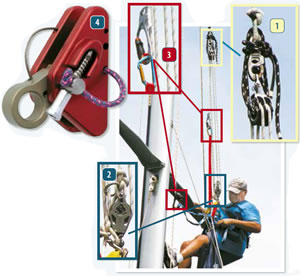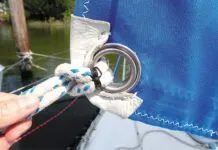
Photos by Patrick Childress and courtesy of Petzl
In the October issue of Practical Sailor, circumnavigator and PS contributor Patrick Childress described a system to simplify going aloft alone. The system, inspired by similar ones that professional riggers routinely use, included some specialized climbing equipment. After reading the article, a few of our readers pointed out that this arrangement made some potentially dangerous assumptions, and they offered suggestions on how to improve it.
The accompanying photos here and the following text will help address these concerns as well as answer questions about the specific gear that Childress used. Readers can also refer to the online article (Getting to the Top, PS October 2014), which has been amended to reflect these changes.
The system Childress describes is a 4:1 purchase block-and-tackle attached to an existing halyard. This hoist is supplemented by two climbing ascenders: one for hoisting, one as a safety arrest should the halyard fail.
The setup featured in the original article is as follows: The top block is a Garhauer double block (60-17 US); the lower block is a 60-millimeter Lewmar single-becket ratchet control block (LW29901665); the line is 7/16-inch Samson XLS Extra T double-braid; the ascenders are Petzl Ascension.
However, as we heard from our readers, the above hardware leaves room for improvement. Here are some of their comments.
Ascenders
Avid rock climber Peter Ekstrom pointed out that the Petzl Ascension ascenders are not designed for self-arrest under the loads that might occur in a fall, nor are they a good choice for use with a double-braid line (as shown in the original photos), he said. If subjected to the shock load of a falling, heavy-set man, these ascenders could tear through the cover of the rope, and a falling man would keep falling. Ekstrom pointed out that the Petzl Microcender is a better choice for this job. However, Petzl advises that even with the Microcenders, there should be no slack in the safety tether.
PS contributing writer and ice climber Drew Frye pointed out that a 250-pound man falling 4 feet would apply more than 1,500 pounds of load on the Ascension ascenders, enough to tear the cover off half-inch Sta-set, a common halyard braid. Frye also pointed out that climbing hardware often isn’t compatible with the low-stretch, braided cover ropes used for halyards, nor will it work well with slippery high-modulus ropes.
Bottom line: Ideally, one would use only the rope and hardware specified by the hardware manufacturer for the type of halyard line used on your boat, and test it before use. Petzls website (www.petzl.com) offers a number of links describing its equipment and proper use, as well as safety precautions.
Block and Tackle
Reader Alan Rothenbush offered his take on the setups lifting hardware. First, he recommended using fiddle blocks with beckets (with the lower block capable of ratcheting). The system we featured had a fiddle block at the bottom, with a double block at the top. Rothenbush reported that in his experience, fiddle blocks imparted less friction on the arrangement.
He also suggested using the largest sheaves possible. A significant portion of the friction in a pulley system comes from simply bending the line, and the greater the bend, the worse it gets, with 180 degrees (our situation here) being as bad as it can be. Larger radius bends from larger sheaves require less effort than tight bends around small sheaves.
Rothenbush also pointed out that the block-and-tackle arrangement means you will not get to the top of the mast and that a simple solution is to attach steps to the top of the mast. Rigger Brion Toss, who offers an excellent video on going aloft on his website (www.briontoss.com), uses a similar system.





































